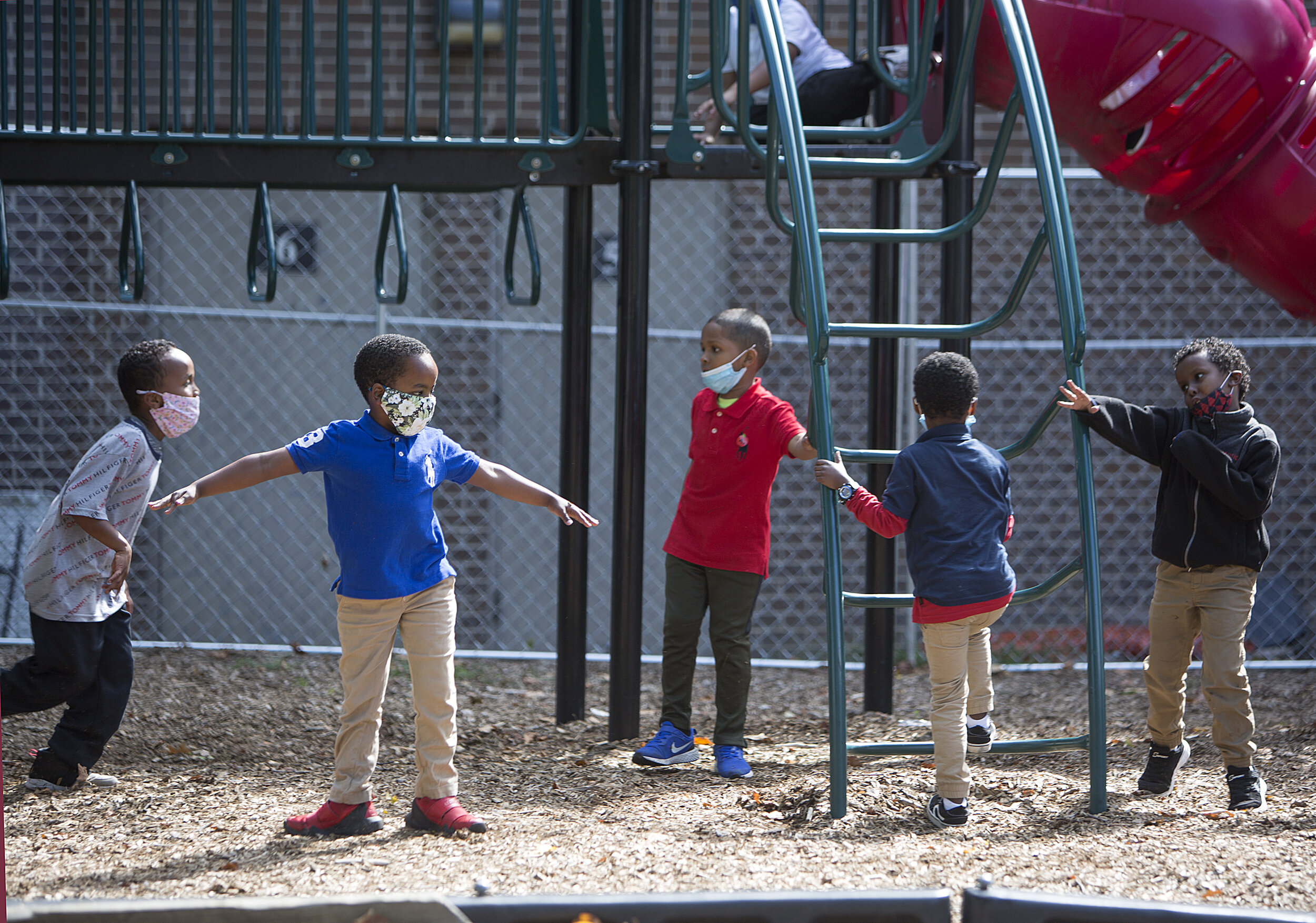Class is in session as Harvest Best Academy gets creative in a pandemic
By David Pierini staff reporter
Harvest Best Academy, like most schools in Minneapolis, have empty hallways and closed classrooms.
Navaeha Broyld-Henigan works quietly behind a plexiglass guard in her kindergarten classroom at Harvest Best Academy. The number of students are limited in each classroom as the public charter school attempts to hold in-class school during the pandemic. Photo by David Pierini
The start to the school year for most students began as the last ended – at home in front of a computer trying to learn while the coronavirus pandemic continues to keep most of society from gathering.
Yet the doors to the K-8 public charter school in North Minneapolis remain open and teaming with students in the mornings to start their day in school, in a classroom alongside classmates.
Harvest has made several creative modifications it hopes that will keep staff and students from catching the virus and engaged in productive learning. About 30 percent of the school's 750 students started the school year in the building and if all goes well, more students and staff will return in mid-October.
“We’ve been trying to put this puzzle together for months,” said Eric Mahmoud, executive director of Harvest. “We’ve been doing a lot of research and trying to figure out what are the best solutions for these multiple problems that have surfaced because of this situation. We’re very conscientious of the decisions that we’re making. Our number one priority this year is the health and safety of our staff and families.”
Gov. Tim Walz in August gave school districts statewide options on how to begin the year. Minneapolis Public Schools opted to continue remote learning but offer in-person support for technology, tutoring and mental health services. Other schools across the metro adopted a hybrid model, with staggered groups of students spending two days a week in class.
A young student attempts to maintain social distance while on the playground for recess. Photo by David Pierini
Harvest’s plan is its own unique hybrid. All the teachers, except for three kindergarten teachers, are teaching from home.
Students in school are on Chromebooks with the teacher and are supervised by paraprofessionals. There are between eight and 12 students in a classroom and they sit at desks with three-side plexiglass sneeze guards. All are masked and sitting furthering than six-feet apart.
When school began in mid-August, kindergarten was held outdoors under tents. School staff gathered every morning at 6:30 a.m. to arrange desks and set up three large canopies.
Since Sept. 8, kindergarten went indoors with eight students per classroom. This requires teachers and paraprofessional splitting time over multiple classrooms so that each kindergartner spends at least half their day with their teacher.
In-person learning for kindergarten, teachers said, is critical. How do you teach a kid to hold a pencil or scissors or ask them to work a keyboard when they have yet to learn the alphabet?
“At first, we thought they would be distracted outside on the playground,” kindergarten teacher Michelle Citarella said. “But they got right into it from the very start. I think it helped to see all of the tents with their friends learning.”
The right building
Harvest, which sits near the corner of Highway 55 and Elwood Avenue North, is three separate buildings in one, each with separate entrances. Children arrive at the entrance of the building they’re assigned and receive a temperature check before entering.
Mahmoud designated each building a pod of no more than 65 students in each. Classrooms have a mix of grades in each classroom, each student wearing earphones as they listen to their teacher. Siblings are also placed together.
Should a student or students test positive in one of the pods, Mahmoud says the building’s design would allow him to shut down the one pod while allowing the others to operate.
The heating and cooling system in each building allowed for easy installation of ceiling-mounted air cleaners that clean the air in the room six times per hour. Classroom doors remain shut so that the cleaners work efficiently, Mahmoud said.
Mahmoud is also working to secure sites in church basements and community centers to create learning pods out in the community that would be supervised by paraprofessionals.
“Sometimes life puts you in a situation where you have to pull out of your narrow thinking and widen your options,” Mahmoud said.
Still best guessing
Since school began, students and staff remain healthy, and teachers have found kids to be surprisingly focused. Mahmoud said the adult support is making every go smoothly thus far.
Kindergarten teacher Michelle Citarella shows a coloring of a student with a bright face mask. Photo by David Pierini
But with all the precautions and layers of protection, the virus continues to chart an uncertain path. It could upend even the best plans. Staff are hopeful but they remain vigilant.
“There is no book written on this, so we’re kind of figuring it out,” Mahmoud said. “At the end of September, we’re going to re-evaluate, see how the community spread is and then determine what’s going to happen in October.”
The future of education?
When Walz shut down in-person learning in March, Mahmoud scrambled to get enough laptops so that each student had one.
Only half of the students turned them on and “I was in tears,” he said. Mahmoud said about 30 percent of the students come from homes where a different language is spoken. Others, perhaps unsupervised because of working parents, were inconsistent with studies.
But more Harvest students, whether at school or home, have been consistently “ turning on” their Chromebooks and adjusting to a different sense of normal.
“To me, this is eye-opening,” he said. “I’ve been reading a lot about learning pods and micro schools and is this the way of the future?
“If I had the best teacher in the world, they just happen to live in Japan, they could teach my children right here. We would just need to make sure that we have the adults to provide the support for them.”



